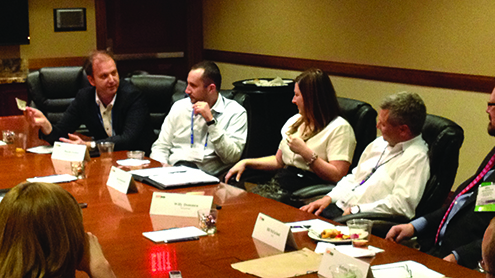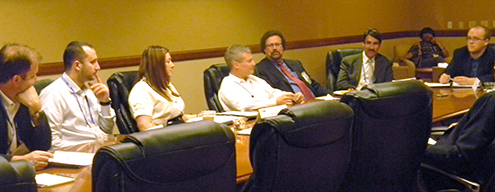
Industry leaders from INIT, SPX Genfare, Accenture and Crane Payment Solutions offer their thoughts on the future of fare collection

During the APTA 2013 Fare Collection Workshop & TransITech Conference, held March 18-20 in Phoenix, AZ, leaders from the fare payment industry met with BUSRide in an informal setting to respond to questions, share perspectives on transit fare collection and speculate on future technologies.
Our guests were representatives from INIT, SPX Genfare, Accenture and Crane Payment Solutions.
Tell us about your company and its most recent contract.
Roland Staib, CEO, INIT: INIT is a provider of ITS systems and has as a long tradition in fare collection systems. We have enjoyed a U.S. presence since 1999 with our most recent contract for a multi-agency smartcard system in Sacramento. Our most recent contract in Europe is in Luxembourg. We like to mention that because if you deliver to Luxembourg, you’re equipping not only a city but a whole country.]
Willy Dommen, Public Transportation, Accenture: Accenture equips back office systems and high-capacity transaction processing systems, such as the PRESTO system operating in Toronto which continues to expand. Ottawa has now adapted the PRESTO card as its payment media. Our other contracts are expanding the PRESTO system to some of the other agencies in the Toronto region.
Tara Farnsworth, Marketing Manager, SPX Genfare: People know us as GFI, but we’re making a major transition to our new company name with SPX Genfare. We’ve been working really hard to change our brand. Our business was founded in fare collection, but now we’re really working to expand well beyond that and into systems, service and other solutions.
A project I like to highlight is Winnipeg Transit. Some of the innovations we’ve created include a new farebox with the capability to scan and print two-dimensional high definition barcodes. We’ll be implementing a web-based fare collection system with them soon.
Bassam Estaitieh, MBA, Product Manager, Crane Payment Solutions: Crane Payment Solutions is a vendor of cash payment devices. We sell coin acceptors, coin validators, coin recyclers, bill acceptors and bill recyclers. We work everything from the low-end to the high-end, from farebox applications for SPX Genfare to the OEM’s ticket vending machines as well. A recent contract in the U.S. is with ACS/Xerox for the Southeastern Pennsylvania Transportation Authority (SEPTA) project. The agency awarded ACS/Xerox, which in turn became our partner in integrating the device. It will be deployed later this year.
Our biggest project by far came last year in Europe. We were awarded the tender for Swiss Federal Rail for about 1,000 ticket vending machines. Scheidt and Bachmann won the contract and the operator specifically requested our bank note recycler in the machine. These are two wins we’re proud of.
Smartcards seem to be replacing paper tickets. What’s the next big step forward for fare collection?
Farnsworth: With Dallas jumping right to mobile ticketing, I think a lot of agencies will start to go that way.
Staib: We agree. Mobile ticketing is a big game-changer.
Dommen: It will alleviate a lot of the infrastructure needed for smart cards and even for tickets. That’s a huge cost advantage to the agencies. It’s not just mobile ticketing. Ticketing is just one type of service an agency can deliver to the customer using the phone as a delivery platform, such as ride information, schedule information and vehicle delays. Clearly the mobile phone is becoming a delivery channel for all kinds of services related to operations.

Where do cash payments stand in all of this?
Dommen: If you look at tolling, the Golden Gate Bridge has eliminated toll collectors and cash. If you’re going to use cash, you can go to an outlet like a 7-Eleven and recharge an account with cash.
Open payments alone will never get rid of cash in a transit system as long as the agency continues to make the decision to accept it. There are people who are not going to go through the bother of even getting a reloadable card. It’s more convenient if they’re operating in a cash-based environment.
Farnsworth: There’s no question cash is diminishing. In my research and talking to our clients, what we see are most large agencies collecting 10 percent cash. Remove rail and it gets as high as 20 percent. A midsized agency collects around 50 percent cash and it skyrockets in smaller agencies. I think it’ll go down every year. Until someone makes the leap from smartcards to NFC or something else, I don’t think you’ll see real change.
Bill McFarland, Director of Technical Services, INIT: The Jacksonville Transit Authority (JTA) put in a closed-loop card, which has showed something like a 40 percent drop in cash.
Farnsworth: A huge number of unbanked people will not stop using cash. It’s going to be a challenging proposition to get rid of it entirely.
Estaitieh: I’d like to comment on that, because we’ve been hearing that cash is going away for so long. Obviously, we’re a cash payment vendor and we have a position on that. In the U.S. over 26 percent of households are unbanked or underbanked (per a 2011 FDIC survey) and don’t necessarily have the funds to store on prepaid cards. They also don’t have access to credit. Additionally, operations like SEPTA want to accept everything in their customers’ wallets, and cash is one of those elements of payment.
Even advanced transit authorities in Europe and Japan still accept cash in their fare payment devices. We don’t think it’s going away. We think cash has already taken as much damage as it’s going to take. Usage might decrease a few percentages from year to year, but if only 10 percent of the ridership needs to use cash then an agency must give those customers the option.
Staib: If an agency can’t get rid of cash entirely, it may be able to switch to retail as the point of sale. A customer may go to a 7-Eleven, put down cash on the card and use that card. But does the operator still have to accept cash on the bus? I guess that’s a big problem.
Farnsworth: Everybody talks about the cost of cash collection, but never the cost of implementing a smartcard. You’re not saving money, you’re just shifting it to a new area.
Estaitieh: There’s a misconception that cash collection is the most expensive thing, but it’s not necessarily the case. No one, for example, tracks the cost of accepting credit cards, which is critical for bus farebox applications because the fixed portion of the credit card transaction fee structure will yield a large percentage cost of accepting credit cards for bus rides.
Is what you’re doing leading to a better perception of transit?
Dommen: Fare media is not going to drive ridership. I call it the pain factor: The cost of gas is rising and it’s too painful to drive the car, so I’m looking for other alternatives.
Paul Doukas, Director, Business Development – Parking/ Transportation, Crane Payment Solutions: What we always have to remember is that public transit is funded by federal dollars. [NOTE: Doukas shows U.S. dollar bill to the group.] This clearly states that this is legal tender. I don’t see that stated anywhere else. As long as government is funding public transit, the agency has to accept cash. As soon as the government stops printing this, we can move into different forms of payment.
McFarland: I think the CTA will be the poster boy of that. They want to get rid of cash.
Dommen: But they are not going to eliminate it entirely. They’re either going to shift it to a third-party merchant or some kind of machine that will reload a card with cash. You’re still accepting cash, just on a different channel. BR
